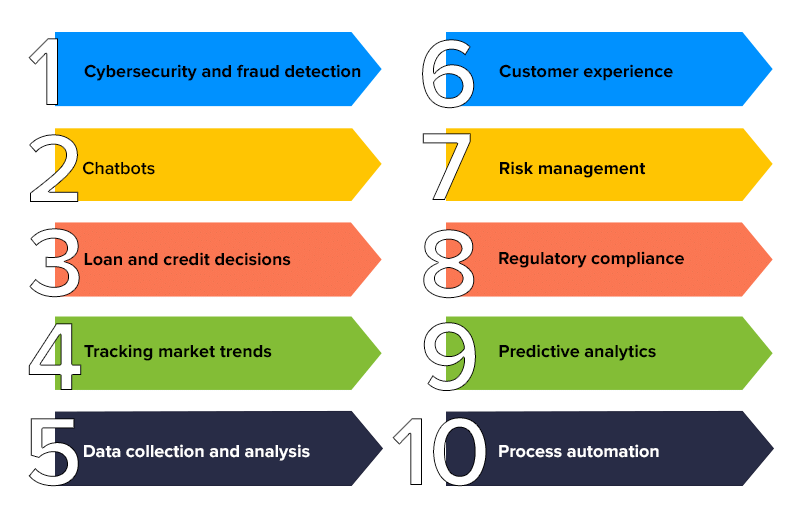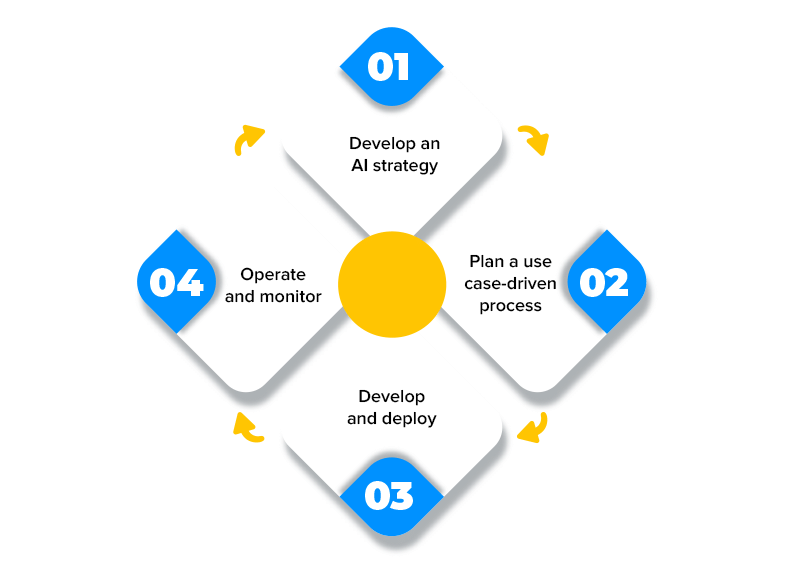Artificial intelligence (AI) technology has become a critical disruptor in almost every industry and banking is no exception. The introduction of AI in banking apps and services has made the sector more customer-centric and technologically relevant.
AI-based systems can help banks reduce costs by increasing productivity and making decisions based on information unfathomable to a human agent. Also, intelligent algorithms are able to spot anomalies and fraudulent information in a matter of seconds.
A report by Business Insider suggests that nearly 80% of banks are aware of the potential benefits that AI presents to their sector. Another report suggests that by 2023, banks are projected to save $447 billion by using AI apps.
These numbers indicate that the banking and finance sector is swiftly moving towards AI to improve efficiency, service, productivity, and RoI and reduce costs.
In this article, we will find out the key applications of AI in the finance and banking sector and how this technology is redefining customer experience with its exceptional benefits.
Applications of AI in banking and finance
Artificial intelligence technologies have become an integral part of the world we live in, and banks have started integrating these technologies into their products and services at scale to remain relevant.

Here are some major AI applications in the banking industry through which you can reap the numerous benefits of the technology. So, let’s dive in!
Cybersecurity and fraud detection
Every day, huge quantities of digital transactions take place as users pay bills, withdraw money, deposit checks, and do a lot more via apps or online accounts. Thus, there is an increasing need for the banking sector to ramp up its cybersecurity and fraud detection efforts.
This is when artificial intelligence in banking comes to play. AI can help banks improve the security of online finance, track the loopholes in their systems, and minimize risks. AI along with machine learning can easily identify fraudulent activities and alert customers as well as banks.
For instance, Danske Bank, Denmark’s largest bank, implemented a fraud detection algorithm to replace its old rules-based fraud detection system. This deep learning tool increased the bank’s fraud detection capability by 50% and reduced false positives by 60%. The system also automated a lot of crucial decisions while routing some cases to human analysts for further inspection.
AI can also help banks to manage cyber threats. In 2019, the financial sector accounted for 29% of all cyber attacks, making it the most-targeted industry. With the continuous monitoring capabilities of artificial intelligence in financial services, the banks can respond to potential cyberattacks before they affect employees, customers, or internal systems.
Chatbots
Undoubtedly, chatbots are one of the best examples of practical applications of artificial intelligence in banking. Once deployed, they can work 24*7, unlike humans who have fixed working hours.
Additionally, they keep on learning about the usage pattern of a particular customer. It helps them understand the requirements of a user in an efficient manner.
By integrating chatbots into banking apps, the banks can ensure that they are available for their customers round the clock. Moreover, by understanding customer behavior, chatbots are able to offer personalized customer support and recommend suitable financial services and products accordingly.
One of the best examples of AI chatbot in banking apps is Erica, a virtual assistant from the Bank of America. This AI chatbot can handle tasks like credit card debt reduction and card security updates. Erica managed over 50 million client requests in 2019.
Also Read: How much does it cost to develop a chatbot?
Loan and credit decisions
Banks have started incorporating AI-based systems to make more informed, safer, and profitable loan and credit decisions. Currently, many banks are still too confined to the use of credit history, credit scores, and customer references to determine the creditworthiness of an individual or company.
However, one cannot deny that these credit reporting systems are often riddled with errors, missing real-world transaction history, and misclassifying creditors.
An AI-based loan and credit system can look into the behavior and patterns of customers with limited credit history to determine their creditworthiness. Also, the system sends warnings to banks about specific behaviors that may increase the chances of default.
Tracking market trends
Artificial intelligence in financial services helps banks to process large volumes of data and predict the latest market trends, currencies, and stocks. Advanced machine learning techniques help evaluate market sentiments and suggest investment options.
AI for banking also suggests the best time to invest in stocks and warns when there is a potential risk. Due to its high data processing capacity, this emerging technology also helps speed up decision-making and makes trading convenient for both banks and their clients.
Data collection and analysis
Banking and finance institutions record millions of transactions every single day. Since the volume of information generated is enormous, its collection and registration turn into an overwhelming task for employees. Structuring and recording such a huge amount of data without any error becomes impossible.
In such scenarios, AI-based innovative solutions can help in efficient data collection and analysis. This, in turn, improves the overall user experience. The information can also be used for detecting fraud or making credit decisions.
Customer experience
Customers are constantly looking for a better experience and convenience. For example, ATMs were a success because customers could avail essential services of depositing and withdrawing money even when banks were closed.
This level of convenience has only inspired more innovation. Customers can now open bank accounts from the comfort of their homes using their smartphones.
Integrating artificial intelligence in banking and finance services will further enhance consumer experience and increase the level of convenience for users. AI technology reduces the time taken to record Know Your Customer (KYC) information and eliminate errors. Additionally, new products and financial offers can be released on time.
Eligibility for cases such as applying for a personal loan or credit gets automated using AI, which means clients can eliminate the hassle of going through the entire process manually. In addition, AI-based software can reduce approval times for facilities such as loan disbursement.
AI banking also helps to accurately capture client information to set up accounts without any error, ensuring a smooth experience for the customers.
[Also Read: 5 ways Fintech industry is using AI to woo millennials]
Risk management
External global factors such as currency fluctuations, natural disasters, or political unrest have serious impacts on banking and financial industries. During such volatile times, it’s crucial to take business decisions extra cautiously. AI-driven analytics can give a reasonably clear picture of what is to come and help you stay prepared and make timely decisions.
AI also helps find risky applications by evaluating the probability of a client failing to pay back a loan. It predicts this future behavior by analyzing past behavioral patterns and smartphone data.
Regulatory compliance
Banking is one of the highly regulated sectors of the economy worldwide. Governments use their regulatory authority to ensure that banking customers are not using banks to perpetrate financial crimes and that banks have acceptable risk profiles to avoid large-scale defaults.
In most cases, banks maintain an internal compliance team to deal with these problems, but these processes take a lot more time and require huge investment when done manually. The compliance regulations are also subject to frequent change, and banks need to update their processes and workflows following these regulations constantly.
AI uses deep learning and NLP to read new compliance requirements for financial institutions and improve their decision-making process. Even though AI banking can’t replace a compliance analyst, it can make their operations faster and efficient.
Predictive analytics
One of AI’s most common use cases includes general-purpose semantic and natural language applications and broadly applied predictive analytics. AI can detect specific patterns and correlations in the data, which traditional technology could not previously detect.
These patterns could indicate untapped sales opportunities, cross-sell opportunities, or even metrics around operational data, leading to a direct revenue impact.
Process automation
Robotic process automation (RPA) algorithms increase operational efficiency and accuracy and reduce costs by automating time-consuming repetitive tasks. This also allows users to focus on more complex processes requiring human involvement.
As of today, banking institutions successfully leverage RPA to boost transaction speed and increase efficiency. For example, JPMorgan Chase’s CoiN technology reviews documents and derives data from them much faster than humans can.
How to become an AI-first bank?
Now that we have seen how AI is used in banking, in this section, we will look into the steps that banks can take to adopt AI on a broad scale and evolve their processes while paying due attention to the four critical factors — people, governance, process, and technology.

Step 1: Develop an AI strategy
The AI implementation process starts with developing an enterprise-level AI strategy, keeping in mind the goals and values of the organization.
It’s crucial to conduct internal market research to find gaps among the people and processes that AI technology can fill. Make sure that AI strategy complies with the industry standards and regulations. Banks can also evaluate the current international industry standards.
The final step in AI strategy formulation is to refine the internal practices and policies related to talent, data, infrastructure, and algorithms to provide clear directions and guidance for adopting AI across the bank’s various functional units.
Step 2: Plan a use case-driven process
The next step involves identifying the highest-value AI opportunities, aligning with the bank’s processes and strategies.
Banks must also evaluate the extent to which they need to implement AI banking solutions within their current or modified operational processes.
After identifying the potential AI and machine learning use cases in banking, the technology teams should run checks for testing feasibility. They must look into all aspects and identify the gaps for implementation. Based on their evaluation, they must select the most feasible cases.
The last step in the planning stage is to map out the AI talent. Banks require a number of experts, algorithm programmers, or data scientists to develop and implement AI solutions. If they lack in-house experts, they can outsource or collaborate with a technology provider.
Step 3: Develop and deploy
After planning, the next step for banks is to execute. Before developing fully-fledged AI systems, they need to first build prototypes to understand the shortcomings of the technology. To test the prototypes, banks need to compile relevant data and feed it to the algorithm. The AI model trains and builds on this data; therefore, the data must be accurate.
Once the AI model is trained and ready, banks must test it to interpret the results. A trial like this will help the development team understand how the model will perform in the real world.
The last step is to deploy the trained model. Once deployed, production data starts pouring in. As more and more data starts coming in, banks can regularly improve and update the model.
Step 4: Operate and monitor
The implementation of AI banking solutions requires continuous monitoring and calibration. Banks need to design a review cycle for monitoring and evaluating the functioning of the AI model comprehensively. This will, in turn, help banks in the management of cybersecurity threats and robust execution of operations.
The continuous flow of new data will affect the AI model at the operation stage. Therefore, banks should take appropriate measures to ensure the quality and fairness of the input data.
Real-world examples of artificial intelligence in banking
A few big banks have already started leveraging artificial intelligence technologies to improve their quality of service, detect fraud and cybersecurity threats, and enhance customer experience.
Here are a few real-world examples of banking institutions that have been utilizing AI to their full advantage.
JPMorgan Chase: Researchers at JPMorgan Chase have developed an early warning system using AI and deep learning techniques to detect malware, Trojans, and phishing campaigns. Researchers say it takes around 101 days for a Trojan to compromise company networks. The early warning system would provide ample warning before the actual attack takes place.
It can also send alerts to the bank’s cybersecurity team as hackers prepare to send malicious emails to employees to infect the network.
Capital One: Capital One’s Eno, the intelligent virtual assistant, is the best example of AI in personal banking. Besides Eno, Capital One is also using virtual card numbers to prevent credit card fraud. Meanwhile, they are working on computational creativity that trains computers to be creative and explainable.
Apart from commercial banks, a number of investment banks such as Goldman Sachs and Merrill Lynch have also integrated analytical AI-based tools in their routine operations. Many banks have also started utilizing Alphasense, an AI-based search engine, that uses natural language processing to discover market trends and analyze keyword searches.
Now that we have looked into the real-world examples of artificial intelligence in banking, let’s dive into the challenges that exist for banks using this emerging technology.
Challenges in the wider adoption of AI in finance and banking
The wide implementation of high-end technology like AI is not going to be without challenges. From the lack of credible and quality data to security issues, a number of challenges exist for the banks using AI technologies.
So, without further ado, let’s take a look at them one-by-one:
- Data security: One of the key challenges of AI in banking is the amount of data collected that contains sensitive information requires additional security measures to be implemented. So, it’s important to look for the right technology partner who will offer a variety of security options to ensure your customer data is appropriately handled.
- Lack of quality data: Banks need structured and quality data for training and validation before deploying a full-scale AI-based banking solution. Good quality data is required to ensure that the algorithm applies to real-life situations. Also, if data is not in a machine-readable format, it may lead to unexpected AI model behavior. So, banks accelerating towards the adoption of AI need to modify their data policies to mitigate all privacy and compliance risks.
- Lack of explainability: AI-based systems are widely applicable in decision-making processes as they eliminate errors and save time. However, they may follow biases learned from previous cases of poor human judgment. Minor inconsistencies in AI systems do not take much time to escalate and create large-scale problems, thereby risking the bank’s reputation and functioning.
To avoid calamities, banks should offer an appropriate level of explainability for all decisions and recommendations presented by AI models. Banks need to understand, validate, and explain how the model makes decisions.
How Appinventiv can help in your AI journey
As we can see AI and banking go hand-in-hand because of the multiple benefits that this technology offers. According to Forbes, 65% of senior financial management expects positive changes from the use of AI and machine learning in banking. Thus, all banking institutions must invest in AI solutions to offer novel experiences and excellent services to customers.
At Appinventiv, we work with banks and financial institutions on different custom AI and ML-based models that help in improving revenue, reducing costs, and mitigating risks in different departments.
In case you are also looking for AI development services, talk to our experts. We can help you create and implement a long-term AI in banking strategy and cater to your needs in the most tech-friendly and cost-effective manner.

Saurabh Singh
MENTOR & DIRECTOR



You must be logged in to post a comment.